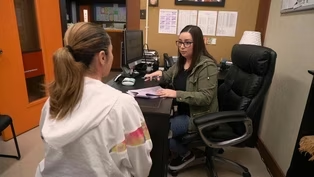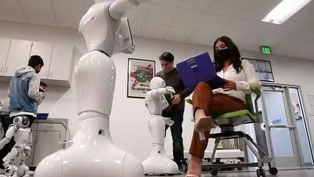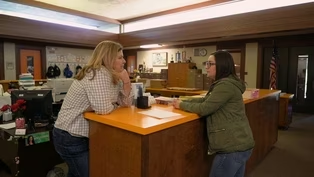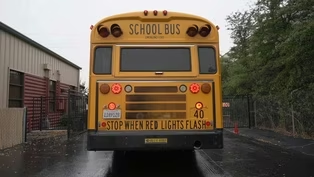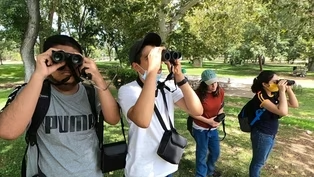Inside California Education
Exploring Careers
Season 4 Episode 10 | 26m 46sVideo has Closed Captions
Go inside a brand-new career technical education center.
Go inside a brand-new career technical education center in Bakersfield. Discover what it takes to learn how to drive a school bus in Rocklin, which is facing a shortage of drivers. Take a stroll along the Merced River with students who are the children of migrant workers in this outdoor education program. Meet a family community liaison in Mendocino County.
Problems playing video? | Closed Captioning Feedback
Problems playing video? | Closed Captioning Feedback
Inside California Education is a local public television program presented by KVIE
Funding for the Inside California Education series is made possible by the California Lottery, SchoolsFirst Federal Credit Union, Stuart Foundation, ScholarShare 529, and Foundation for the Los Angeles Community Colleges.
Inside California Education
Exploring Careers
Season 4 Episode 10 | 26m 46sVideo has Closed Captions
Go inside a brand-new career technical education center in Bakersfield. Discover what it takes to learn how to drive a school bus in Rocklin, which is facing a shortage of drivers. Take a stroll along the Merced River with students who are the children of migrant workers in this outdoor education program. Meet a family community liaison in Mendocino County.
Problems playing video? | Closed Captioning Feedback
How to Watch Inside California Education
Inside California Education is available to stream on pbs.org and the free PBS App, available on iPhone, Apple TV, Android TV, Android smartphones, Amazon Fire TV, Amazon Fire Tablet, Roku, Samsung Smart TV, and Vizio.
Providing Support for PBS.org
Learn Moreabout PBS online sponsorshipAnnc: Coming up on Inside California Education...
Teacher: Up here we have safety instructions.
We also have safety instructions back here.
Annc: Go inside this brand new, state-of-the art Career Technical Education Center in Bakersfield, where high school students are learning employable skills, ranging from robotics to warehouse jobs.
Isabelle: Everybody comes in here, in this class, and they go straight to work because they love what they're doing.
Annc: Discover what it takes to learn how to drive a big yellow bus in Rocklin.
Like many districts around California, Rocklin is facing a shortage of qualified school bus drivers.
Matt: There has been a school bus driver shortage since the 90s, as far as I know, and COVID has just made that worse.
Annc: And stroll along the Merced River with these students from a unique Migrant Education Program, which aims to further their education in an outdoor setting.
Adrienne: Being able to get them out here and walking around and experiencing it, um, it allows them to take a breath, it allows them to build relationships with other students in a safe environment.
Annc: Meet a family community liaison in Mendocino County, who helps bridge the gap between students and their families, many of whom speak a language other than English.
Andrea: Just listening to them and making sure that they understand that we care, um, helps a lot.
Annc: It'’s all next - on Inside California Education!
Funding for Inside California Education is made possible by: At the California Lottery, we'’re focused on our mission to provide supplemental, essential funds to public schools - kinder through college.
Helping to keep teachers on staff.
Or pay for new school computers, band equipment, and other instructional materials and services.
Since 1985, we'’ve raised more than 37 billion dollars.
And more than 95 percent of our sales go back to the community.
Music to all of our ears.
California Lottery - helping schools and communities across California.
The Stuart Foundation: Improving life outcomes for young people through education.
ScholarShare 529: California'’s state-sponsored, tax-advantaged 529 college savings plan designed to help pay for the cost of higher education.
Additional funding for Inside California Education is made possible by these organizations supporting public education.
♪♪ ♪♪ Isabelle: I wake up every day ready to come to this class.
I definitely feel fortunate to be here.
Rob: What high school student, Isabelle, feels fortunate about is being part of this robotics engineering class at the Career Technical Education Center in Bakersfield.
The state of-the-art facility, also known as CTEC, offers students hands-on training in nearly 40 career pathways at two career training centers.
Dean: The goal of this program is to provide students an opportunity to envision a future that they may not have been able to envision in a traditional classroom, trying to learn about something abstractly.
Rob: Each day, students from 23 area high schools in Kern County arrive at the CTEC campus to spend three hours learning the skills needed in their chosen career path.
Brian: You walk into any class, and you've got students from all over the community, from all different high schools they went to, but they're all here because they have a similar interest in a given career field.
And so, it really creates this kind of unique environment.
Stephen: It's unbeatable.
I can'’t imagine a situation where a student would learn robotics engineering solely from a textbook.
I think it comes down to students getting their hands on the equipment, manipulating it, and then crawling inside of a platform in a group dynamic.
You could walk into this class at any time and see a student programming a robotic arm... Student: 3... 2... 1... Go.
♪♪ ... or you might see them programming a humanoid robot to greet you as you come in the door, or maybe to guide somebody.
Robots that you would see maybe at Tesla or all the way to Space X, and the kids are then fueled by their own creativity.
Melissa: I like the freedom to be creative.
He really just lets us do projects that we want to do.
Put our own staple on it.
So, it's really fun.
You'll be seeing me work on the Jenga project.
I enjoy troubleshooting because the satisfaction at the end of troubleshooting is really amazing.
Stephen: I think I have the best job in the world.
I walk in every day, and I step into a lab setting with students and I can see breakthroughs that they're having personally where, you know, it's a big struggle sometimes to get a robot to do what you want.
And I'm not going to hold their hand all the time.
Students need to be self-sufficient.
They need to find the answers.
A big portion of this program is confidence.
Are you confident to troubleshoot a problem?
Isabelle: I have learned that I thrive under pressure.
That's when I can actually do my best.
It's not just about the success, it'’s what leads up to it.
It is the struggles, the obstacles.
That's what I fell in love with.
Rob: Isabelle'’s plan is to pursue a career in aerospace engineering.
Isabelle: I am fascinated by everything that has to do with spacecraft.
I think the future is up there.
Stephen: At the end of the day, my hope is that students are confident that no matter what comes in industry, no matter what comes in life in the next decade, they can tackle it.
And I'm excited to unleash these kids on that workforce because I'm confident that they're going to be able to tackle any problem that could come up.
Rob: On the other end of campus, students in the logistics and distribution program are operating forklifts in a 10,000 square foot warehouse.
Mitchell Moretti: They learn about how the supply chain works at a very base stage.
So, how a product goes from a raw material, all the way to the customer.
We're able to take what we learned in class and then apply it to the warehouse.
Daniel: It's awesome.
I love it, it'’s actually a really good class.
It'’s a great experience.
I am certified in forklifting, and I am certified in warehouse.
So, I can fully operate a forklift in any warehouse in California.
Mitchell: I'm one of their last steps before they enter the real world and just being able to prepare them for life.
I'm teaching them skills that they can take and get a job.
And these are good paying jobs right off the bat.
A majority of my students are at-risk or have some type of learning disability.
And what's really cool is they come in thinking that they have a learning disability and then I'm able to show them hands-on ways of learning, and they pick it up better than some of my other students.
Rob: Daniel is one of those students.
He'’s among the approximately 120 students at these training centers with a learning disability.
Daniel: I'm diagnosed with dyslexia, so it's hard for me to get my learning experience.
So, dyslexia is a learning disability that you have to learn from hands-on, I don'’t learn from verbal.
So, I'’m a little bit different than other people, and I'’ve always taught myself to do better, to push yourself.
Teacher: Up here, we have safety instructions.
We also have safety instructions back here.
Any questions?
Daniel: No sir.
Teacher: Alright.
Good job.
Daniel: The teacher, Mr. Moretti, he'll push you.
He will definitely push you a lot and you learn to push yourself way out of your comfort zone, you're going to figure out who the person that you're going to be.
And I figured out that the person I'm going to be is a passionate and a hard worker and I'm willing to do anything.
Rob: Students say this is where they have found self-discovery, growth, and a wide array of new career opportunities.
Isabelle: This school has brought so much to me.
I have learned so much about myself.
This is where my natural talent is.
This is what I love doing.
That's something that's going to stay with me for the rest of my life and that means everything.
Annc: Career technical education helps students be ready for both college and career.
Within two years, 80% of career tech students are likely to go to college or a postsecondary program.
Nearly 95% of those who don'’t attend college had paying jobs within two years.
High-risk students are ten times less likely to drop out in 10th and 11th grade if they enroll in a career technical education program, instead of a general program.
♪♪ Matt: First thing you always have to do is make sure your seat is well adjusted.
Your seat belt is on.
Because you don'’t want to adjust your mirrors and then have to move your seat forward.
Christina: Matt Sanchez has worked in the school bus industry for more than 30 years - starting out as a school bus driver himself.
Now, he'’s the director of transportation for Rocklin Unified School District, overseeing a fleet of 30 school buses.
He'’s also recruiting and training new bus drivers, for a job that'’s like no other on a school campus.
Matt: It really requires somebody to be able to have excellent multitasking skills.
Uh, when I talk to teachers, they say, wow, you know, I have student management issues with one on 30 students face to face, but if they were to turn that desk around and put their back to those students, they said they would never do that.
And so, our school bus drivers turn their back to the kids with a mirror to look at them.
And there's 84 students behind them.
So, first of all, take a look at all your mirrors, and I want to make sure you understand the different mirror systems we'’ve got.
Christina: Training new drivers is more important than ever right now.
Rocklin has seven open driver positions.
And school districts across California are facing a driver shortage.
Matt: There has been a school bus driver shortage since the 90s, as far as I know, and COVID has just made that worse.
♪♪ Christina: A national survey recently found that 51% of respondents say they have either a "“severe"” or "“desperate"” driver shortage.
91% have had to alter their bus services to elementary schools.
When asked the reason behind the shortage, the majority cited: pay rate, length of time to receive a license, availability of benefits, and hours available to work.
Matt: We'’re all kind of in this together trying to get through this driver shortage, and we'’re doing our best to attract people to this position.
That's why every school district is using all the resources they have.
Because the impact of one driver not being at work today is a domino effect on so many students.
Christina: Rocklin has had to get creative to fill the shortage.
Many people don'’t like working a split shift, so the district has found ways to offer them more work.
Hasani Bates is a district mechanic but agreed to learn how to drive buses, as well.
Marsha Bolser drives a white passenger van, while also training how to drive the big yellow bus.
And Gary Hopping is a retired police officer, who actually enjoys the split shift.
Gary: Personally, I like to be able to, in the middle the day, take my dog for a walk, do things you need to do around the house out and about, and then come back to work.
Christina: Gary recently completed his training and is now driving students on his own.
Gary: Why didn'’t the skeleton do well in school on Monday?
>>: Why?
Gary: His heart wasn'’t in it.
Moving that big bus through this city is challenging.
I thought it'’d be kinda easy.
I think I'’m a decent driver, but I was really challenged just when I started getting through this neighborhood.
It was challenging.
On my route, I've got a bunch of great students.
I've got elementary school, junior high and high schoolers, and they're all really good students.
Matt: He has a genuine love of driving.
He challenges himself every day and he loves kids and people.
Gary: Every day is a challenge.
Driving that bus through the city is a challenge.
And when I get back here to the office at the end of the route, I feel good about that.
Christina: Despite being a mechanic by trade, Hasani didn'’t hesitate when the district needed help.
Hasani: During the interview, they were like, there's a school bus driver shortage.
Would you be interested in, um, helping us out with that?
And I told them I would.
Christina: He says he'’s learned a lot - about all the rules and regulations, but also how important this job is to the children'’s well-being.
Hasani: You have to be very mindful of yourself as a school bus driver.
Because how you greet the children is the start of their learning experience.
So, and also, how you, um, when you pick them up after school, how you interact with them is going to kind of dictate how their going home is going to be like.
So, you just- you got to be mindful.
Matt: We teach all of our drivers, the importance of the social aspect of driving a school bus.
What happens on that bus is going to have a direct educational impact when they leave the bus and go in that classroom.
Marsha: Yes, I can pick you up on the right crossover.
My thing is - if I can do it, anybody can do it.
At first you get, you know, a little anxiety, but once you do it every day, it- you're just like- it's second nature to you.
Matt Sanchez: It's... it's the person who enjoys kids and enjoys driving.
And if you enjoy those two things, we can train you how to become a very good school bus driver.
Christina: Most school districts spend between 80 to 120 hours training each new driver - going far beyond the minimum.
That'’s because districts know just how important this job is.
Matt: Our parents are taking their kids to a bus stop to get onto a bus with a driver they've never met before.
So, they're... they're really, um, trusting the school district to find the best people on the- out there to be able to safely transport their students.
And, um, it's really rewarding because you see every single day that you're having an impact on people's lives in a positive way, especially kids.
Annc: Still ahead on Inside California Education...
Journey outside with a new summer education program from the Merced County Office of Education.
It introduces the children of migrant workers to scientific concepts in the great outdoors.
But first- spend a day in the life of a family community liaison in Ukiah.
We followed her prior to the pandemic, as she helped students and families attain school services.
Andrea Perez: It makes me feel good that I can be that person for these families, that they can go to for any question that they have.
♪♪ I feel like what helps me in this job is that I can relate to students because I have been where they are at, I'’ve gone through similar situations... but I also can relate to the parents because my parents and I were really- we had a really strong relationship, and I know what their side of it is like.
My name is Andrea Pérez, and I am the Family Community Liaison at Pomolita Middle School.
So, here at Pomolita Middle School, we have about 750 to 800 students and about half of those are Hispanic.
A lot of those families have moved here from Mexico... they don't know English, and some of them don't even know how to read or write, so I help a lot with that too.
I connect with them and give them whatever help I can.
I was born here but I lived in Mexico for a few years, so I came back when I was in second grade and it was really difficult for me because back then, there weren't many Spanish speaking people on the school staff.
I always had to go with my parents and be the translator because they don't speak English.
When I heard about this job, I thought it would be- I thought it was a great job to begin with because there's someone at the school who can help parents like mine to translate and to help them with filling out paperwork, fill out anything, and they don't have to worry about those kinds of things.
So, we're a really good resource for them.
They can call us with any question, and we can find out for them and help them in the best way that we can.
It makes me feel good that I can be that person for these families that they can go to for any question that they have.
If they need to know anything about our school or about the community, they can come and ask me.
If I don't know the answer, I'll find out and get back to them, but I think it's really important to have someone that anybody can go to.
I have a parent on the phone who I'’ve been talking to for a little while, and she really wants to talk to you about some issues she'’s having with her student.
When would be a good time for you guys to meet?
I think the key to helping parents relax and trust us is to just listen to them.
Make sure that their concerns are heard and that they know that we're doing something about it.
Just listening to them and making sure that they understand that we care, helps a lot.
It puts their mind at ease, I think, because they know that there's someone that they can automatically go to.
I enjoy helping them connect with who they need to connect to.
I think that without this position at our schools, it would be more difficult for parents to connect and I really, really like talking to them and just getting their story and being able to help them.
When I go home at the end of the day, I just feel really accomplished for being there for people, being there for parents, whether they're speaking English or Spanish.
But most especially the Spanish-speaking families because I was there for them, and I did the best I could to help them, and it makes me feel really good.
And I think back to when I was younger, and we had the same issues... so, I just told my mom, like, I just feel really, really lucky to be here and to help these parents with all of these things.
♪♪ Emely: This year, I proposed to myself to try new things.
Like, whether it be going out somewhere or, like, just socializing with people.
That's what motivated me more to come out here and greet these people that I don't know, and, like, try new things.
Annc: Emely isn'’t the only student trying new things today.
She'’s one of several students in a new outdoor summer program at Henderson Park, along the picturesque Merced River.
It'’s part of Merced County Office of Education's Migrant Education Program, which supports more than 9,000 children of migrant workers who live in the Central Valley.
Adrienne: Many of the students that we're bringing out here have never really taken time to slow down and look at a river and to look at all of the life around the river and the way the river flows, um, and to slow down and kind of appreciate how that interaction affects them.
Matt Edwards: We'll have students from Stanislaus, from Los Banos area, and Atwater-Merced area.
Um, these students are involved in the Migrant Education Program.
They live at our migrant camps in the area.
Adrienne: And these are the... the... the children of the seasonal workers, uh, and those seasonal workers, you know, they travel a lot.
So, these are students who, um, may not feel as much success in a traditional classroom, and so being able to get them out and learn about things in a real-world environment, uh, and how- allow them to make their own connections, um, allows that autonomy that some of those students really need and desire.
Annc: The outdoor summer program is easing these students back into in-person learning after a year of learning remotely, due to Covid.
They have the opportunity to take a hike, go birding and look for wildlife, and journal or draw the environment around them.
♪♪ Clementine: I do love drawing, but, like, drawing, like, a scene was something new for me, because I normally just drew stuff that I saw, like small items, but like drawing like a whole scene of something was quite beautiful to see that, so I could draw it by myself.
Matt: One of the goals in getting students outside is the social-emotional side, where they're interacting with other students, interacting with teachers... so, the kids will get a chance to see wildlife, insects, things that they don't normally see.
So, this is a way to get those students out, to see a larger section of the world around them instead of just their migrant camp.
Martha: This is my first time actually, and I kind of like it so far.
We've been observing how the current has been going, how narrow it was and how... how big it changed.
Adrienne: Being able to get them out here and walking around and experiencing it, um, it allows them to take a breath, it allows them to build relationships with other students in a safe environment.
Emely: This is a new thing.
I honestly- I think I like it better out here and I...
I'm not sitting in the- on the... in the desk and just staring at a computer.
Like, I'm actually looking around, talking to people and observing things, it's just better, honestly, than being in front of a computer.
Christina: Because migrant workers move frequently for seasonal work, their children often experience interruptions in their education.
The students may have other unique challenges that programs like this one hope to address.
Matt: We have some first year English and some that have already, very fluent in reading and writing.
So, we tried to add aids and supports in the journaling for students that are still learning the language.
So, this is definitely an opportunity for students to see stuff that they don't normally get a chance to see.
Something outside of the school setting.
Adrienne: They can actually kind of process their own thoughts of how it's going and then have the freedom to share, but not the requirement to... to share what they've written in their journals, um, builds a camaraderie, um, with them as they have this shared experience.
Steve: One of our long-term goals of this program is to grow it so that we are able to offer this kind of field trip experience to students during the entire school year.
So that future generations can enjoy the same kinds of things that we're enjoying today with our students from the Merced County Migrant Education Program.
♪♪ Christina: For Emely, today'’s program not only met her goal of trying new things, but also taught her how to be an observer.
Emely: Like, I've been out in other places, but I'’ve never been, like, focused on, like, watching the animals or hearing them.
I feel like it'’ll make me be more aware and be- observe things more.
Adrienne: Every student has a different passion and if they can connect their passion to the environment around them, it's gonna make their lives a lot easier.
Annc: Migrant education has a long history in the United States.
In the 1950s and 60s, many migrant children were more likely to work alongside their parents in the fields than attend school.
Only one out of ten migrant children would graduate high school.
That began to change in 1966, when Congress created the Migrant Education Program.
Today, more than 300,000 migrant children in the U.S. are eligible for services, with the goal of reaching academic standards and getting a high school diploma.
That'’s it for this edition of Inside California Education.
If you'’d like more information about the program, log on to our website: insidecaled.org.
We have videos from all of our shows, and you can connect with us on social media.
Thanks for joining us.
We'’ll see you next time on Inside California Education.
♪♪ ♪♪ Funding for Inside California Education is made possible by: At the California Lottery, we'’re focused on our mission to provide supplemental, essential funds to public schools - kinder through college.
Helping to keep teachers on staff.
Or pay for new school computers, band equipment, and other instructional materials and services.
Since 1985, we'’ve raised more than 37 billion dollars.
And more than 95 percent of our sales go back to the community.
Music to all of our ears.
California Lottery - helping schools and communities across California.
The Stuart Foundation: Improving life outcomes for young people through education.
ScholarShare 529: California'’s state-sponsored, tax-advantaged 529 college savings plan designed to help pay for the cost of higher education.
Additional funding for Inside California Education is made possible by these organizations supporting public education.
A Day in the Life – Family Liaison
Video has Closed Captions
Clip: S4 Ep10 | 3m 40s | Meet a family community liaison in Mendocino County who helps bridge the gap. (3m 40s)
Exploring Careers in Robotics, Distribution and Logistics
Video has Closed Captions
Clip: S4 Ep10 | 6m 41s | Go inside a brand-new career technical education center in Bakersfield. (6m 41s)
Preview: S4 Ep10 | 30s | Go inside a brand-new career technical education center. (30s)
Filling the Bus Driver Shortage
Video has Closed Captions
Clip: S4 Ep10 | 5m 37s | Discover what it takes to learn how to drive a school bus in Rocklin. (5m 37s)
Migrant Education – A Day at the River
Video has Closed Captions
Clip: S4 Ep10 | 5m 48s | Take a stroll along the Merced River with students who are children of migrant workers. (5m 48s)
Providing Support for PBS.org
Learn Moreabout PBS online sponsorship
- News and Public Affairs

Top journalists deliver compelling original analysis of the hour's headlines.

- News and Public Affairs

FRONTLINE is investigative journalism that questions, explains and changes our world.












Support for PBS provided by:
Inside California Education is a local public television program presented by KVIE
Funding for the Inside California Education series is made possible by the California Lottery, SchoolsFirst Federal Credit Union, Stuart Foundation, ScholarShare 529, and Foundation for the Los Angeles Community Colleges.
